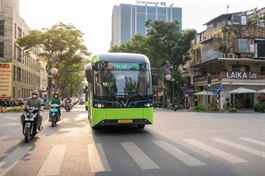Banks struggle to keep up with CAR standards upgrade
Banks struggle to keep up with CAR standards upgrade
Despite ongoing efforts by banks to raise capital and improve their capital adequacy ratios (CARs), the pace of improvement remains slow, and the system-wide CAR in Vietnam is still low compared to regional peers.
|
Circular No.14/2025/TT-NHNN dated June 30 regulates the CAR for commercial banks and foreign bank branches, and tightens capital standards on a set timeline, so many banks, especially state-owned ones, are facing mounting pressure to increase capital.
Raising charter capital is a key metric for expanding asset scale and credit growth but also serves as a buffer to enhance their ability to withstand financial risks.
In the first quarter of 2025, the total charter capital of state-owned commercial banks listed on the stock exchange was VND207.47 trillion ($8.3 billion), 2.1 times higher than 10 years ago. Private commercial banks showed a more impressive surge, with charter capital rising from a lower base to almost VND609 trillion ($24.36 billion), a 3.3-fold increase over the same period.
However, Vietnam’s CAR remains among the lowest compared to countries in the region and globally. Hoiwever, the CAR of several banks has been improving slowly over the years, especially among state-owned commercial banks.
Nguyen Quang Thuan, chairman of FiinGroup, said that Vietnam's banking sector still has a low CAR. As estimated, by the end of 2024, the system-wide CAR was only around 12.5 per cent, while credit growth remained high and supplementary capital did not keep pace. Among them, the "big four" state-owned banks' CAR was lower, at approximately 10.5 per cent, while other commercial banks maintained a CAR above 12 per cent.
In regional markets such as Singapore and China, or foreign-invested banks in Vietnam like ANZ and Shinhan Bank, CAR can reach 25 per cent, which reveals a significant gap compared to domestic banks.
Thuan noted, "Raising CAR from 12.5 to 25 per cent in the next three years is nearly impossible, even though capital pressure is increasing due to the roadmap in Circular 14. For state-owned banks, the government may be reluctant to dilute ownership or allocate additional funds from the state budget, posing a serious challenge regarding how and from where to raise capital."
Circular 14 will take effect from September 15, replacing Circular No. 41/2016/TT-NHNN with the aim of aligning more closely with Basel III capital adequacy standards.
Although Circular 14 sets stricter requirements for CAR, with higher minimum thresholds, it also includes several adjustments to the calculation of credit risk-weighted assets under the standardised approach. These adjustments are designed to support specific lending segments, such as personal loans and loans to small- and medium-sized enterprises (SMEs).
For example, personal loans in the agriculture and rural sectors will be assigned a 50 per cent risk weight instead of the previous default of 100 per cent. Personal loans with outstanding balances under VND8 billion ($320,000) will see their risk weight reduced from 100 to 75 per cent. Social housing loans will be assigned flexible risk weights ranging from 20 to 50 per cent, depending on the specific risk level. Loans to SMEs will have their risk weight slightly reduced from 90 to 85 per cent.
For real estate lending, the default 200 per cent risk weight will no longer apply automatically. It will only be applied if the borrowing enterprise fails to provide financial statements or has negative equity.
The implementation roadmap of Circular 14 is divided into two phases to allow credit institutions to gradually adapt and comply. Accordingly, during the transitional phase until December 31, 2029, banks are allowed to choose between two methods of calculating the CAR under either Circular 14 or Circular 41, after registration with the State Bank of Vietnam. In the full implementation phase starting from January 2030, all banks must apply the standardised approach in Circular 14.
- 17:12 31/07/2025

























